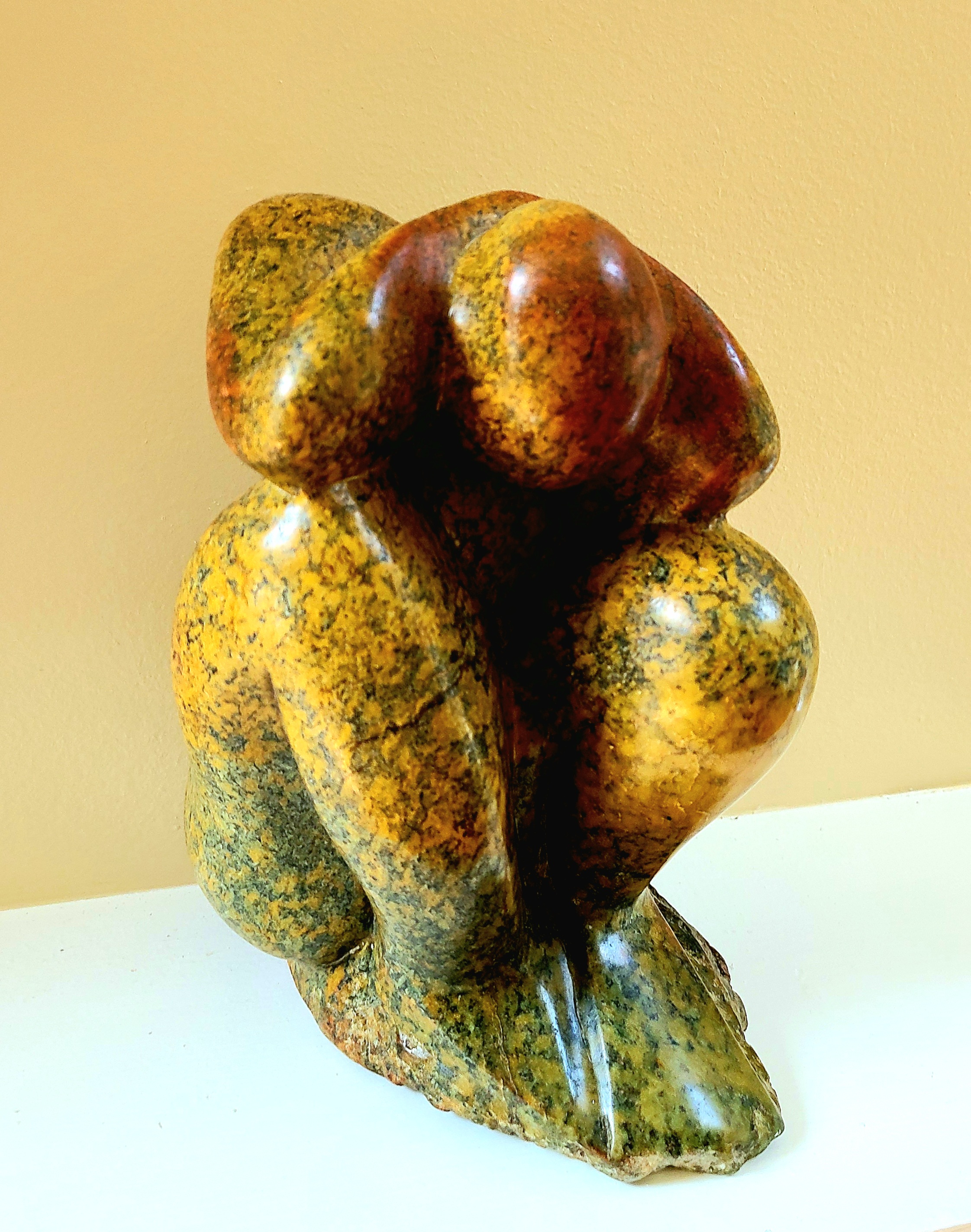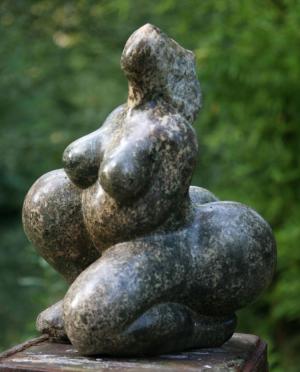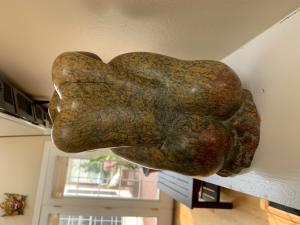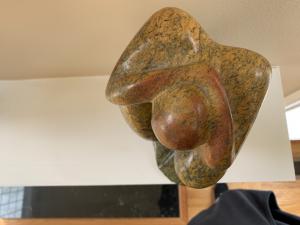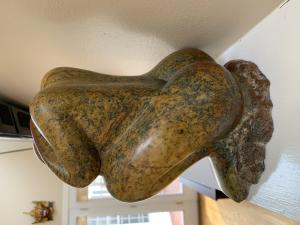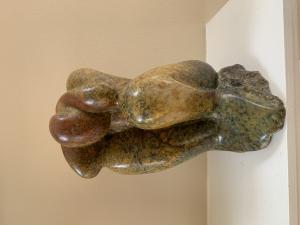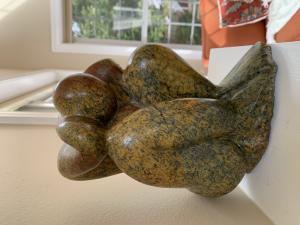Meditation Two
Artwell Chipiri
Sculpture
This fruit serpentine sculpture by Artwell Chipiri depicts a human figure in a crouching position, with the hands behind the neck and the head leaning deep down in a suggestively introverted/meditative moment. Although Artwell mostly works on sculptures of female bodies, his figures are immediately recognizable among other Shona sculptors - they always have enlarged body parts, some even grotesque proportions, mostly in the lower body, as we see here in the disproportionally large knees and lower legs, as well as the suggested size of the feet, significantly larger than the figure’s head. A comparison to the Colombian figurative artist and sculptor Fernando Botero has been brought up, as both he an Chipiri work with exaggerated human and animal forms (see comparison of their treatment of the female nude in sculpture above; on the left is Bolero, on the right Chipiri). However, where Bolero's work is quite monumental, Artwell's sculptures feel more organic and abstract and emanate an aura of intimacy. They never show discernible human faces that would make the sculpted body into a particular human, but through this anonymity allude to the universal - of a female body, a contemplating man, etc.
Artwell’s sculpture brings to mind the long tradition of representations of meditative and thinking poses throughout art history, most notably the work of Rodin and his sculpture the Thinker (*Such comparison to European art is not totally out of place here as McEwen, the patron of the Shona movement, was the curator of the Rodin Museum in Paris before whis work in Africa and was known to encourage young Shona artists to sculpt along more modernist lines. Their sculptures are displayed in the Rodin museum even until today, implicitly suggesting possibilities of stylistic connections and read as displays of “universal” aesthetic ideas and styles that crossover between European/Western and Exotic/African).
Significantly, although the title of this work suggests meditation, the figure itself does not bring to mind a typical meditative pose, which would (in any kind of meditation) usually feature a more open body pose, suggestive of the spirit’s openness to the world. Rather, we see here a more closed-off pose, typical more of thinking poses in sculptural history that present a moment of inwardly closing oneself from the world. The position of the hands behind the neck and the lowering of the head here creates almost a sense of fear and overpowering forces from the outside, which might have its roots in the subjective and historic moments of Zimbabwean history.
Artwell's words about this piece:
"Thank you so much for appreciating my work. The pieces which you are talking about in fruit serpentine which is my favourite stone. The piece depict a man deep in thought. Meditation is like one pulls oneself together to bring body and spirit together levelling and working out a balance both physically, emotionally and spiritually find lasting solutions to a situation. The piece was done in year 2008 in Chitungwiza Art Centre."
Artwell’s sculpture brings to mind the long tradition of representations of meditative and thinking poses throughout art history, most notably the work of Rodin and his sculpture the Thinker (*Such comparison to European art is not totally out of place here as McEwen, the patron of the Shona movement, was the curator of the Rodin Museum in Paris before whis work in Africa and was known to encourage young Shona artists to sculpt along more modernist lines. Their sculptures are displayed in the Rodin museum even until today, implicitly suggesting possibilities of stylistic connections and read as displays of “universal” aesthetic ideas and styles that crossover between European/Western and Exotic/African).
Significantly, although the title of this work suggests meditation, the figure itself does not bring to mind a typical meditative pose, which would (in any kind of meditation) usually feature a more open body pose, suggestive of the spirit’s openness to the world. Rather, we see here a more closed-off pose, typical more of thinking poses in sculptural history that present a moment of inwardly closing oneself from the world. The position of the hands behind the neck and the lowering of the head here creates almost a sense of fear and overpowering forces from the outside, which might have its roots in the subjective and historic moments of Zimbabwean history.
Artwell's words about this piece:
"Thank you so much for appreciating my work. The pieces which you are talking about in fruit serpentine which is my favourite stone. The piece depict a man deep in thought. Meditation is like one pulls oneself together to bring body and spirit together levelling and working out a balance both physically, emotionally and spiritually find lasting solutions to a situation. The piece was done in year 2008 in Chitungwiza Art Centre."
Stone carving has been a part of Zimbabwean culture since the 1200s and re-emerged as a modern sculptural tradition in the 1950s, known as the “Shona movement”. The driving force behind this art renaissance was Frank McEwen, director of the Rhodesia National Gallery from 1957 to 1973. McEwen encouraged and supported aspiring artists as they started the movement that would quickly become world-renowned. International collectors and critics were amazed at the rigour, spontaneity and originality of the works coming from an area of Africa which had none of the great sculptural heritage of West Africa and had been previously described as rather barren in terms of its visual arts. Contrary to other artistic tendencies and movements coming out of Africa in the post-colonial period, Shona sculptures were not looking back at the tradition of functional sculptural objects inspired by traditional customs and rituals, rather they found their sources in the present and created sculptures that blend the contemporary moment with the memories and dreams of their tribal past (the so-called “tribal consciousness” that was thematically encouraged by McEwen). Up to today, artists, without preliminary studies, spontaneously carve out semi-abstract shapes of birds and other animal or human forms imbued with ancestral symbolism, expressing an integral part of present day Shona folklore and religious beliefs.
Height: 9”
Width: 6”
Depth: 6”
inches
Phoenix, AZ
Chitungwiza Arts Centre, Zimbabwe
*Technique: These Zimbabwean sculptures are made strictly with hand, no power tools are used at any stage of the process and generally, everything is created free-form, ie. there are no preliminary sketches. The tools consist of hammers, points, chisels, rasps and chasing hammers, and the finishing of each sculpture takes almost as long as the process of creating it. The smooth effect is achieved by “washing” the sculpture, using wet and dry sandpaper and if the artist wants a high polish on the stone, the stone is heated and covered with wax (for a more detailed description of the sculpting process, see ID 48)
*Material: The sculpture is carved out of fruit serpentine, a colourful variety of the traditional Zimbabwean serpentine stone that mostly comes from the Kwekwe area, south-west of Harare. Fruit serpentine is usually a very colourful, pretty stone, with deep veins of layered colours. Beside springstone and leopard rock, fruit serpentine is one of the harder varieties of serpentine stones. Because of its beauty, its fine finish, durability and hardness, it is one of the most sought after stones for Shona sculpures.
Artwell Chipiri was born in 1972 in Harare, the third born in a family of six. Two of his brothers are also sculptors and after finishing school at the age of 19, Artwell was inspired to become one as well. Artwell says, “I did not secure employment – instead I created my own. With the visual powers I possess, I feel that life gives me the scope for my powers and emotions… With the concepts of excellence and perfection in my heart, I am sure I will reach great heights”. His work has been displayed in galleries all over the world, from Zimbabwe, to Germany, South Korea and the United States. In 2005, Artwell spent some time in South Korea, attending workshops and exhibitions. He is currently the vice-chairman of the Chitungwiza Arts Centre in Zimbabwe.
